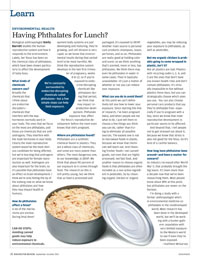In Review
 CAN-DO STEPS: Avoiding canned goods may help reduce exposure to environmental chemicals. (Photo: iStockphoto)
CAN-DO STEPS: Avoiding canned goods may help reduce exposure to environmental chemicals. (Photo: iStockphoto) (Photo: Corbis)
(Photo: Corbis)Biological anthropologist Emily Barrett studies the human reproductive system and how it responds to the environment. Lately, her focus has been on the chemical class of phthalates, which have been shown particularly to affect the development of baby boys.
What kinds of chemicals concern you?
Broadly the chemicals that I think about are endocrine disruptors—chemicals that interfere with the way hormones normally work in your body. The ones that we focus on the most are phthalates, and those are chemicals that are anti-androgens. They interfere with the male hormones in your body. Clearly the male reproductive system would be the most obvious candidate for being affected, but we’re learning that androgens are important for female reproduction as well. Androgens are also important for the brain, so it’s possible that phthalates have an effect on brain development. I think we’re only hitting the tip of the iceberg now on what we know about phthalates and how they may impact health in humans.
How do phthalates affect a fetus?
A lot of the mechanisms are unclear. During fetal development body systems are just developing and maturing, they’re growing, and cell division is very rapid, so we know that environmental insults during that period tend to be most harmful. We think the reproductive system develops in the late first trimester of pregnancy, weeks 8 to 12, so if you’re exposed to endocrine-disrupting chemicals like phthalates during that period, we think that may impact reproductive development. Phthalate exposure may affect the fetus’s reproductive development before the mom even knows that she’s pregnant.
Where are phthalates found?
Phthalates are a synthetic chemical found in plastics. They are a whole class of chemicals, and some are more potent than others. The most dangerous one, to our knowledge, is DEHP. We think that about 90 percent of our exposure to it comes through food. The research on this is still pretty young, but we think that as food is processed and packaged, it’s exposed to DEHP. Another main source is personal care products: shampoos, soaps, perfumes, and so on. Phthalates are really good at holding color and scent, so we think anything that’s scented, more or less, has phthalates. We think there may even be phthalates in water in some cases. They’re basically unavoidable—it’s just a matter of whether or not you can reduce your exposure.
What can you do to avoid them?
At this point we can’t definitively tell you how to lower your exposure. Since starting this line of research, I’ve been pregnant twice, and when people ask me what to do, I just tell them to choose a few things you think you can do, rather than trying to eliminate all possible sources. The easiest one is not to microwave foods in plastic, because we know that chemicals will leach out. And choosing fresher foods—not canned goods, not ones that are highly processed, not fast food.
And another reason to choose organic foods is that phthalates are often included as a non-active ingredient in pesticides. So by choosing organic chicken or organic vegetables, you may be reducing your exposure to phthalates, as well as pesticides.
But my organic chicken is probably going to come wrapped in plastic, isn’t it?
Not all plastics are bad. Plastics with recycling codes 1, 2, 4, and 5 are the ones that don’t have any known health risks and don’t contain phthalates. It’s virtually impossible to live without plastics these days, but you can strategically choose which ones you use.
You can also choose personal care products that say they’re phthalate-free—especially if you’re pregnant with a boy, since we know that male reproductive development in particular seems to be affected.
And beyond that, I tell people not to get stressed out about it, because we know that stress is also not good for the fetus. So it’s kind of a careful balance.
How long have phthalates been around—and been a matter for concern?
As industry increased after World War II, that probably brought the big boom. It’s been more than a decade now that we’ve been researching them. Most people know about BPA at this point, but phthalates are newer on the horizon.
I’m doing a study with a former anthropologist who’s in environmental medicine on phthalates in the nondeveloped world. Most research has been done in the developed world, but we’ll be working with a hunter-gatherer population with very limited exposure to the Western world to see if even they’ve been exposed.
—Kathleen McGarvey
PSYCHOLOGYTaking ‘Ghosts’ Out of the Nursery
The American Professional Society on the Abuse of Children gave its Outstanding Research Career Achievement Award to Sheree Toth in July. A professor of psychology and executive director of Mt. Hope Family Center, Toth has focused her career on preventing child maltreatment and developing approaches to help children who have been abused.
What issues have been the focus of your career?
I work on the effects of maltreatment on the development of children, looking at things such as how it affects their sense of self, their self-esteem, and their views of adults in their lives. Not surprisingly, maltreatment has a very negative effect on the security of children’s attachment to their caregiver—and that negative model spills over to other relationships in children’s lives, with peers, teachers, and others. They can have difficulty forming positive relationships, and it can continue into adulthood.
Children who’ve been maltreated often end up being revictimized as adults, entering into situations involving domestic violence. A big part of my work has focused on how we can break that negative developmental cascade, providing interventions for children in maltreating families. I think some of my most important work to date has looked at providing a relational form of intervention called child-parent psychotherapy where we work with children and their primary caregiver together, to stop the abuse and also to mend the negative effects that the child has experienced.
What does it involve?
Many of the parents with whom we work have themselves experienced significant adversity in their childhood, so when they come to us they may not even know how to play with their child because no one ever played with them. The model emanates from the work of social worker Selma Fraiburg, who wrote “Ghosts in the Nursery,” an article about the “ghosts” of a parent’s own early years, traumas that, left unresolved, can enter their relationship with their own children. Our therapy work isn’t
parent skills training. It’s meeting the parent and child where they are and gently helping them see what’s going on in their interactions. As you develop a more trusting relationship with the mom—most of the parents involved are mothers—you can start reflecting on her experiences when she was young. It’s a longer-term model of therapy—typically weekly meetings for 10 to 12 months.
Are the effects of maltreatment the same for all children?
No. Some children are able to function resiliently despite early adversity. And one thing we’re trying to look at is what helps children do well despite maltreatment, so that we can build that into the development of early-intervention strategies.
What role is there for the larger community in preventing child abuse?
If we don’t help maltreated children, we’re putting in place a lifelong cascade of negative outcomes that affect not only the children and the families they’re in, but also society more broadly. We’re spending about $124 billion a year on ancillary costs related to traumatized children. They’re at much greater risk of developing mental health problems. They’re at much greater risk of dropping out of school. They’re at much greater risk of committing crimes and ultimately being incarcerated. They require a high level of special education services. Maltreatment has also been linked to physical problems, such as increased risk for cardiovascular disease and diabetes.
If I see someone growing frustrated with a child, what can I do as a bystander?
Dante Cicchetti, who was the director of the center for many years, had a great approach to that. We’ve all seen the grocery store scenario, where the child is crying and the mom is yanking him. Dante would go up to the mom and say, “Your little boy looks so much like you, and I can see what a special relationship the two of you have.” And it would just change the whole tenor of the interaction. The mom would smile, and it really would avert what could have turned into something ugly. If we see something in the community that is alarming in some way, trying to divert it in a positive way, walking up and handing someone a balloon or just doing something to divert them and diffuse it, can help. Because confronting a parent at that point could just make it worse.
—Kathleen McGarvey

